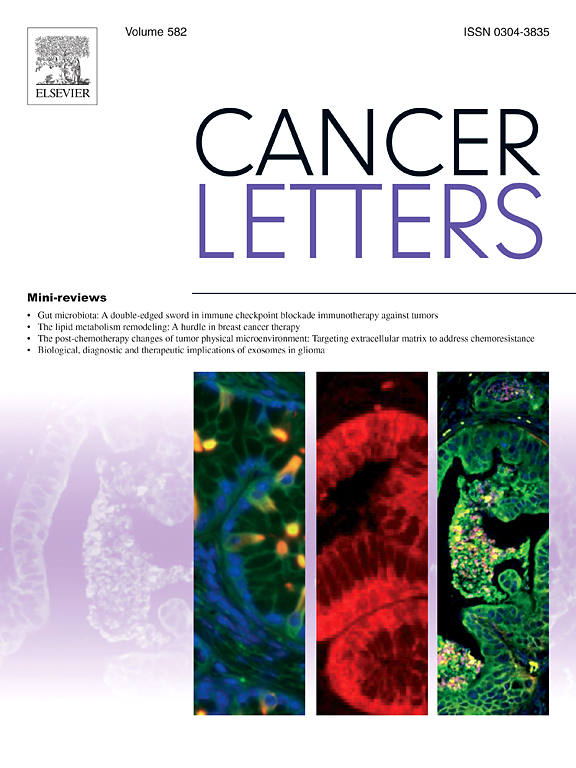A necrosis inducer promotes an immunogenic response and destroys ovarian cancers in mouse xenografts and patient ascites organoids
IF 9.1
1区 医学
Q1 ONCOLOGY
引用次数: 0
Abstract
Most ovarian cancer patients present with advanced disease and there are few targeted therapies; consequently, five-year survival for ovarian cancer remains below 50%. We described the anticipatory unfolded protein response (a-UPR) hyperactivator, ErSO, which induced profound and often complete regression of breast cancer in mouse models. Here we explore the effectiveness of ErSO against ovarian cancer. ErSO induced death of human PEO4 and Caov-3 ovarian cancer cells in vitro. In mouse xenografts, injected ErSO induced rapid complete, or near complete, regression of orthotopic metastatic PEO4 tumors and of Caov-3 ovarian tumors. Ovarian cancer patients often develop malignant ascites containing ovarian cancer organoids that drive metastasis. ErSO showed activity against 7/7 fresh patient derived ascites organoids (PDAOs). Low nanomolar ErSO destroyed 2/7 PDAOs. ErSO-mediated cell death in PDAOs occurred through the same a-UPR activation mechanism seen in cell culture. Moreover, ErSO family compound-induced a-UPR activation in ovarian cancer cells triggers necrotic cell death and release of damage associated molecular patterns (DAMPs), which strongly activated human macrophage and induced monocyte migration. These studies suggest ErSO has unusual potential for treatment of advanced ovarian cancer.
坏死诱导剂促进免疫原性反应并破坏小鼠异种移植和患者腹水类器官中的卵巢癌
大多数卵巢癌患者病情晚期,很少有靶向治疗;因此,卵巢癌的五年生存率仍然低于50%。我们描述了预期未折叠蛋白反应(a-UPR)高激活因子ErSO,它在小鼠模型中诱导了乳腺癌的深刻且通常是完全的消退。本文探讨ErSO对卵巢癌的治疗效果。ErSO体外诱导人PEO4和Caov-3卵巢癌细胞死亡。在小鼠异种移植物中,注射ErSO诱导原位转移性PEO4肿瘤和Caov-3卵巢肿瘤快速完全或接近完全消退。卵巢癌患者经常发展为恶性腹水,其中含有卵巢癌类器官,可驱动转移。ErSO对7/7新鲜患者源性腹水类器官(PDAOs)有活性。低纳摩尔ErSO破坏2/7 PDAOs。在PDAOs中,erso介导的细胞死亡通过与细胞培养中相同的a-UPR激活机制发生。此外,ErSO家族化合物在卵巢癌细胞中诱导的a-UPR激活引发坏死细胞死亡和损伤相关分子模式(DAMPs)的释放,从而强烈激活人巨噬细胞并诱导单核细胞迁移。这些研究表明,ErSO在治疗晚期卵巢癌方面具有不同寻常的潜力。
本文章由计算机程序翻译,如有差异,请以英文原文为准。
求助全文
约1分钟内获得全文
求助全文
来源期刊

Cancer letters
医学-肿瘤学
CiteScore
17.70
自引率
2.10%
发文量
427
审稿时长
15 days
期刊介绍:
Cancer Letters is a reputable international journal that serves as a platform for significant and original contributions in cancer research. The journal welcomes both full-length articles and Mini Reviews in the wide-ranging field of basic and translational oncology. Furthermore, it frequently presents Special Issues that shed light on current and topical areas in cancer research.
Cancer Letters is highly interested in various fundamental aspects that can cater to a diverse readership. These areas include the molecular genetics and cell biology of cancer, radiation biology, molecular pathology, hormones and cancer, viral oncology, metastasis, and chemoprevention. The journal actively focuses on experimental therapeutics, particularly the advancement of targeted therapies for personalized cancer medicine, such as metronomic chemotherapy.
By publishing groundbreaking research and promoting advancements in cancer treatments, Cancer Letters aims to actively contribute to the fight against cancer and the improvement of patient outcomes.
 求助内容:
求助内容: 应助结果提醒方式:
应助结果提醒方式:


